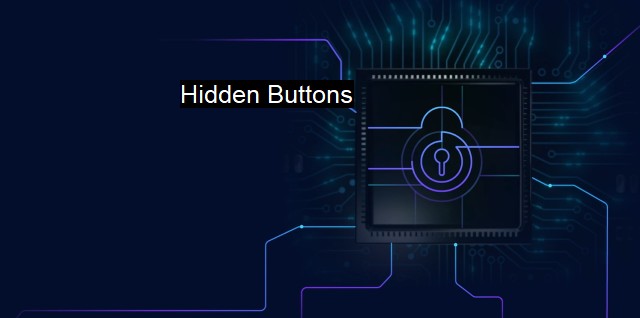What are Hidden Buttons?
Silent Threats: The Rise of Hidden Button Malware and How to Protect Yourself
As technology continues to evolve and permeate every facet of our daily lives, cybersecurity and antivirus systems are becoming increasingly critical. One concept garnering attention in this sphere is "Hidden Buttons."A 'hidden button' refers to an embedded code or feature in a software application or website that isn't visible to the standard user. They may act as triggers for different functions that facilitate smooth system operations or serve malicious intents. While not all hidden buttons have cybersecurity implications, some can act as gateways for cyber-attacks, making them a significant concern for cybersecurity professionals.
From the cybersecurity standpoint, hackers can cleverly design hidden buttons for their nefarious goals. They can position them such that users unintentionally click on them while navigating a webpage or application. This accidental click can then activate these hidden functions, leading to non-consensual activities such as the activation of certain scripts coded to execute harmful actions. Such activities can include the download of malware, harvesting of sensitive data, or even restricted control over the user's system.
When hidden buttons serve as a cover for these disguised scripts, most antivirus systems fail to detect them because they're coded to identify and block apparent threats. Thus, a malicious hidden button can bypass these security protocols, posing significant challenges to cybersecurity effectiveness.
Hidden buttons show a direct correlation to cross-site scripting (XSS) attacks. XSS is a cybersecurity threat where attackers inject malicious scripts into content designed to be visible to end-users, taking advantage of the trust a user has for a website to extract confidential data or other personal information.
Phishing attempts can also utilize hidden buttons, where an attacker, via mimicry of a trusted source such as a bank or social network, lures a user into clicking an inconspicuous button. Upon the click, script activated could install malware, enabling credential harvesting or enabling remote system control.
Hidden buttons can exist in the form of transparent, zero-sized, or layered buttons, which manipulate the user interface interactions. While the users' attention is on the visible user interface, they unknowingly interact with these hidden aspects, leading to potential unauthorized access, breaches, and the spread of malware.
Hidden buttons can also create an additional layer of risk in mobile applications. Simply touching the screen, a natural action for mobile users, can interact with a hidden button and initiate a harmful process.
Now that the risks associated with hidden buttons are apparent, it's equally important to understand how antivirus systems and cybersecurity approaches can tackle them. Understanding and identifying hidden buttons is a complex process. Cybersecurity researchers are adapting ways to identify hidden interface elements, detecting button layers and size properties, and studying the consequences of interaction with such elements.
Achieving effective strategies require innovative ways to dissect and understand the operation of applications and websites, the interaction parameters that define user-execution, and underlying scripts' nature.
Antivirus systems are also evolving to match these challenges. They incorporate behavioral-based detection methods, eliminating the reliance on virus definitions alone. This approach focuses on identifying the behavior pattern of applications and websites, making it possible to detect malign operations that might use hidden buttons.
Processes such as ethical hacking, regular audits, routine inspections of system logs, adopting least-privilege principles could be effective measures against mitigating hidden button-related attacks.
Thus, the sensitivity of hidden buttons in our modern digital landscape demands heightened user awareness and refined cybersecurity strategies to face these silent threats and maintain a safe, secure technological atmosphere.

Hidden Buttons FAQs
What are hidden buttons in relation to cybersecurity and antivirus?
Hidden buttons are a type of malicious code that is embedded in a software application or website. These hidden buttons are designed to perform unauthorized actions or steal information from the user's device without their knowledge or consent.How do hidden buttons work?
Hidden buttons work by exploiting vulnerabilities in software applications or websites to gain access to the user's device. Once activated, the hidden buttons can perform a range of malicious actions, such as stealing sensitive information, installing malware, or taking control of the device remotely.How can I protect my device from hidden buttons?
To protect your device from hidden buttons, you should ensure that your antivirus software is up-to-date and configured to scan all incoming files and emails for potential threats. Additionally, you should avoid downloading software or clicking on links from untrusted sources, and regularly update your operating system and web browser to patch known vulnerabilities.What should I do if I suspect my device has been compromised by hidden buttons?
If you suspect that your device has been compromised by hidden buttons, you should immediately disconnect from the internet and run a full virus scan using your antivirus software. If your antivirus software is unable to detect or remove the hidden buttons, you may need to seek the assistance of a cybersecurity professional to manually remove the malware and secure your device.| | A | | | B | | | C | | | D | | | E | | | F | | | G | | | H | | | I | | | J | | | K | | | L | | | M | |
| | N | | | O | | | P | | | Q | | | R | | | S | | | T | | | U | | | V | | | W | | | X | | | Y | | | Z | |
| | 1 | | | 2 | | | 3 | | | 4 | | | 7 | | | 8 | | |||||||